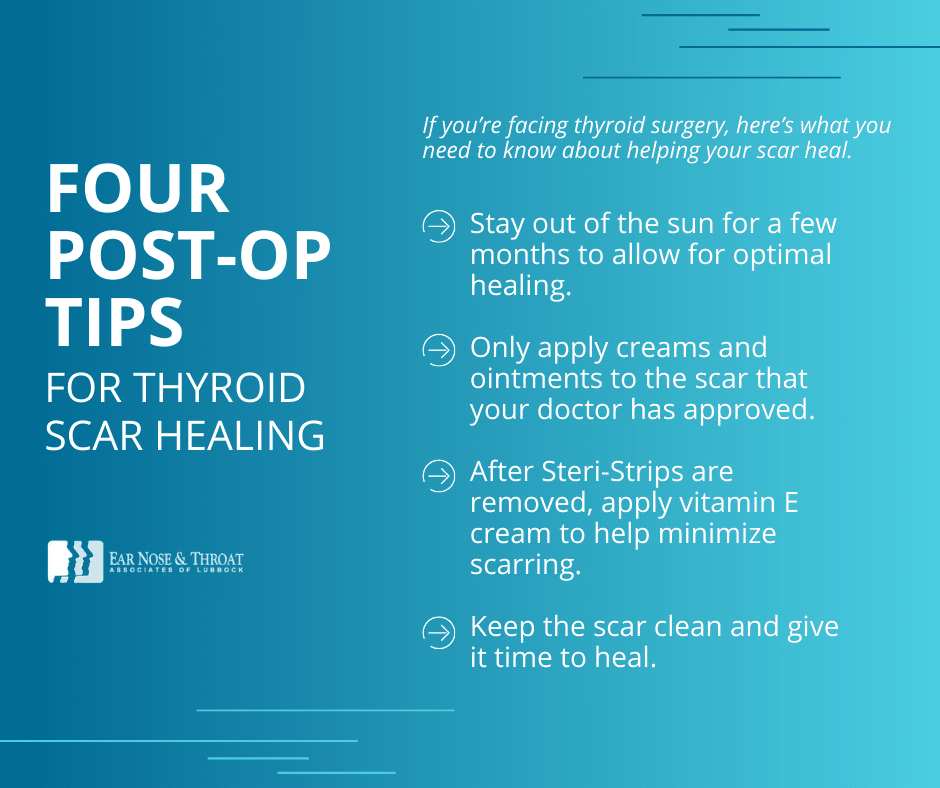Thyroid Surgery Scars: Everything You Need To Know

Do you fear a thyroid surgery scar more than the surgery itself?
If you’re like most patients, once they realize how rare it is to experience more serious complications in the hands of a high-volume thyroid surgeon, they start to dread the scar that will be left behind more than the operation.
After all, no one wants an ugly scar running down their neck and chest for the rest of their lives… and rightly so! Fortunately, it doesn’t have to be like that anymore. Now, with the right placement, length, and surgical closure, we keep thyroid surgery scars to a minimum.
If you’re facing thyroid surgery, here’s what you need to know about what’s happening and how your scar will heal:
Where Is The Thyroid and What Does it Do?
The thyroid is the gland in the lower neck responsible for our metabolism. There are two lobes (right and left), connected across the windpipe by a bridge called the Thyroid Isthmus.
The gland makes thyroid hormone — a hormone that’s vital to life. You literally can’t live without it. This hormone maintains our energy level. If hormone production decreases, the metabolism slows, causing people to gain weight and become sluggish.
Autoimmune thyroiditis and other thyroid issues come when people’s thyroids stop working. When this happens, we can easily replace thyroid hormone. Even if they haven’t had the gland removed, these patients take a thyroid hormone supplement. If the entire gland is removed, thyroid hormone is a necessity.
Who’s Most Susceptible to Thyroid Problems?
Women experience more thyroid problems, autoimmune thyroiditis, and thyroid nodules than men. In fact, if a man has a thyroid nodule, we can become more concerned because it’s less common and may indicate the potential for thyroid cancer.
How Will You Minimize Scarring?
We now make thyroid incisions higher and shorter to minimize the appearance of a scar. Years ago, people had long scars in the chest area from thyroid surgery. Now, we like to make the incision higher in the neck. The higher the better and often hiding it in a skin crease to reduce visibility. As we age, the skin naturally drops. The higher we place the incision, the less likely it falls to the chest area.
We also make a straight, short incision, closing the 4-5 centimeter incision with sutures below the skin. By doing so, we give our patients the finest, thinnest scar possible.
By placing the incision in a good location with a plastic surgery closure, the scar appearance ages well and very few people opt for any scar revisions later on.
Who Is Most Likely To See Thyroid Surgery Scars?
People with a history of keloids (excess scar tissue) may experience more scarring after thyroid surgery. However, the location on the neck minimizes the likelihood of keloids.
Also, people with darker skin tones may seem to have more noticeable scars due to the contrasting color of pigmentation in scar tissue and skin color. However, all scars improve with time. After our inflammatory response and collagen boost, they progress from red to white over the course of the year. As the skin continues to heal, the scar eventually will almost disappear.
Children and young adults may actually notice more prominent scarring due to their active immune systems. As people age, they won’t notice much redness or scarring because the skin doesn’t have the same degree of inflammatory reaction.
Will I Experience Swelling?
After thyroid surgery, expect mild swelling in the neck.
Some surgeons may opt to use a small drain depending on the patient’s needs. If a drain is used, there will be less fluid and swelling. Without a drain, patients may notice mild swelling which the body will eventually absorb.
To reduce swelling, patients may opt to sleep propped on a pillow or use ice packs on the incision. Swelling will resolve within two weeks.
Related: Minimally Invasive Thyroid & Parathyroid Surgery FAQ

Post-Op Tips For the Best Healing
After your procedure, protect the area from the sun for a few months to allow for optimal healing.
Also, only apply creams and ointments to the scar that your doctor has approved. We often see allergic rashes develop over scars when patients experiment with creams on fresh scars. Even antibiotic ointment (like Neosporin) can cause a reaction. These ointments create a problem that otherwise wouldn’t have existed.
In reality, scar care is basic. We apply Steri-Strips immediately after surgery and leave them on for one week. You will want to avoid pulling at the Steri-Strips, scrubbing the area vigorously or focusing a harsh jet of water directly on the surgical site when bathing in the week following surgery. Once the Steri-Strips are removed, patients can opt to apply vitamin E cream to help minimize scars if they choose.
Otherwise, just keep the scar clean and give it time to heal.
Don’t let fears of a thyroid surgery scar make you apprehensive about your coming procedure. Because of the way we operate and locate the incision, most patients are very happy with the thyroid scar’s appearance all in good time.
Dr. Scolaro is a board-certified Otolaryngologist servicing the South Plains area. He has been practicing in Lubbock since 1990 and has earned a reputation as a skilled and experienced surgeon. He currently serves as the Medical Director for Covenant High Plains Surgery Center campuses, is a member of Covenant Health Partners and is an adjunct faculty professor for Texas Tech University Health Sciences Center School of Medicine. Learn more about Dr. Scolaro.
Categories:








